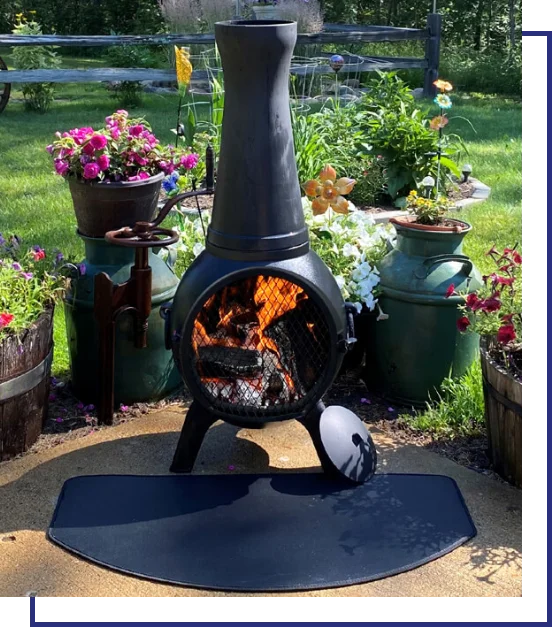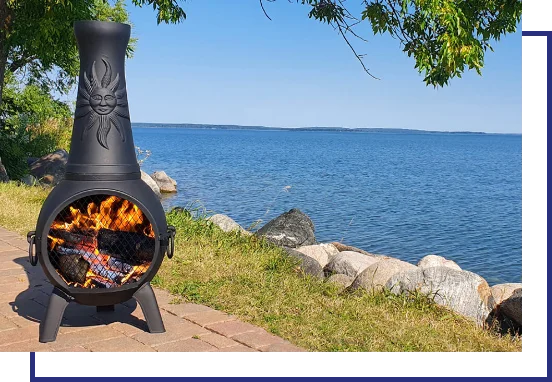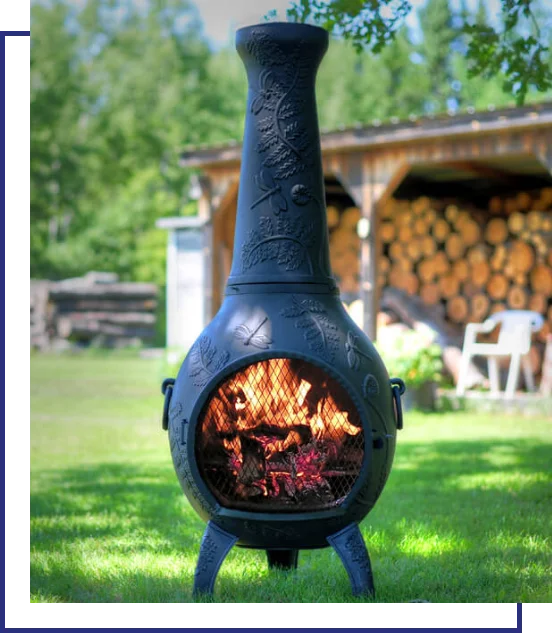Outdoor Fireplace Buying Tips
Outdoor Fireplaces, Fire Pits, and Chimineas
Keep in mind that you are buying a “fireplace”, the type of outdoor chiminea or fire pit you use has a direct effect on your family, your property, and possibly your neighbors. A well-built traditional chiminea provides the safety and flexibility for you to enjoy a lifetime of campfire stories.
The Blue Rooster 10 Chiminea buying tips provided below are for you to make an informed purchase decision. If you are still not sure if one of our chimineas is right for you, feel free to call us. Everyone at the Blue Rooster Company has a chiminea at home, we are very familiar with outdoor fireplace chimineas and firepits. We look forward to talking with you.

A well designed chiminea burns clean, with little or no smoke.
There are 2 basic designs of outdoor fireplaces, Chiminea and Fire Pits. A chiminea can be defined as a single mouth opening fireplace that has a chimney to efficiently fuel the fire with fresh air. A Fire Pit will have a 360 degree view of the fire, or multiple openings with little or no drafting action.
360 degree open fireplaces are like a raised ring of rocks. They may have a chimney, but overly large or 360 degree opening prohibits proper drafting. Without proper drafting a fire will smolder due to inadequate airflow creating excess smoke that can be uncomfortable for you and annoying to your neighbors. There are some small burn barrels that improve the burn process. But unless you like staring down at your fire or live in the streets of New York, a smoleless burn barrel is more of a heating novelty then a true fireplace experience.
Don’t be fooled by companies calling their fire pits chimineas. A fireplace with neck openings and little room for embers/ash is just a fancy firepit. Since they do not burn clean, they will leave behind large amounts of unburned ash and charcoal. You’ll be better off with a ring of rocks in the yard and a cozy chiminea on your deck.
The design of a good chiminea creates a drafting action, drawing fresh air into the fire to get the most Btu’s from your firewood. The fire burns hotter and cleaner, leaving behind only a small amount of ash and very little, if any, smoke during a fire.
Chimineas enclose a fire, protecting people and property. Blue Rooster Company chimineas all designed for efficient drafting. Making them easy to light, efficient, and clean burning outdoor fireplaces.
Cast Iron and Cast Aluminum outdoor fireplaces last the longest.
Chain store and mass marketed fireplaces made of copper, sheet steel, or clay, do not provide the safety or longevity of cast iron or cast aluminum. The Blue Rooster Company has owned, burned and studied about every type of outdoor fireplace. If you have any questions before purchasing a chiminea, please give us a call.
Here is a comparison of different materials:
Clay chimineas need to be babied; “Feed slowly, keep warm and dry.” If you want a fireplace that is going to be safer and last longer, any other material on the market is a better investment. Clay fails from moisture and movement. Thermal shock is not an issue, a warranty for thermal shock is as good as a warranty against meteor strike. If you plan to move your fireplace for patio arrangements or yard use, then a clay chiminea is not a good option.
Sheet Metal outdoor fireplaces can melt or warp, enamel finishes disappear and exposed thin sheet metal rusts out quickly. Once they rust through their usefulness is gone. They can be found in big box stores or online at a bargain cost because they are disposable items. There are outdoor fireplaces made of heavy sheet steel that promotes longevity. They should be treated like cast iron fireplaces and special attention should be made to location because they are not easy to move. Look close at sheet steel designs because most likely they cannot be used on a deck or patio.

Copper looks great out of the box and is a very safe material used for years in cooking utensils. Watch out for steel supports or bases that can rust quickly. Also, don’t expect that shiny new copper fireplace to look like that after a fire or two. Green and tarnished is usually the norm after it’s been used. If you don’t mind the look of it, make sure it has a cover or rain lid and prepare to maintain or replace pop rivets, screws and/or nuts and bolts.
Sheet Aluminum has become popular lately because of the high cost of copper. Check assembly parts carefully before buying. These fail primarily because the assembly parts are not heavy duty and not replaceable. Sheet aluminum since its thin can also lose its protective finish and oxidize quickly.
Stainless Steel fire pits are available. Some are completely welded and others are held together with pop rivets, screws and/or nuts and bolts. These fasteners may or may not be resistant to corrosion. What makes stainless steel “stainless”, is a chromium oxide layer on a steel surface. If this layer is damaged, be it as a result of the manufacturing process or high heat exposure, the exposed metal is able to be attacked and your stainless steel will show signs of rust. Stainless steel works great for mouth screens and hardware. But complete Stainless steel fire pits and chimineas are not recommended.
Cast Iron is heavy, up to 200 lbs.+ and not easy to move once in place, so location should be considered. They tend to rust quickly and you will need to keep some high temp spray paint handy to keep them looking new. Maintenance consists of painting occasionally with high temperature stove paint to inhibit rust. But if you like the patina finish, the only maintenance you will have is an occasional ash clean out. The Blue Rooster recommends cast iron chimineas for commercial use, campgrounds, and places that they will be used without supervision. 200 pound chimineas tend not to “walk away”.
Cast Aluminum is the best investment for your money if low maintenance and mobility are priorities. The Blue Rooster Co. aluminum chimineas are cast from the same molds as cast iron and are up to 3/4″ inch thick in places. The Cast Aluminum will not warp, crack, or rust and is lighter than cast iron so it can be easily moved if needed. Cast aluminum has very little maintenance, a shot of high temp spray paint when needed will keep one looking new for years to come. We paint ours each spring. It only takes a few minutes and it’s like getting a new chiminea every year. A small price to pay for something that will last a lifetime.

Compare weight and size when shopping.
When comparing chimineas compare a copper model to a copper model, cast iron to cast iron model, cast aluminum to cast aluminum and so on. Beware of “mixed” models that have part cast iron and part sheet steel. There are also a few that mix cast aluminum and cast iron.
Many companies sell what is called a “Cast Iron” model that is made mostly of sheet steel. In some instances the body is cast iron but the neck or chimney is sheet steel. Eventually, you will be left with a cast iron body without a neck. If you need to buy new replacement parts frequently it’s probably better to look elsewhere.
If you decide to get a cast iron chiminea, see The Blue Rooster’s Prairie style Cast Iron. A Cast Iron Prairie weighs a whopping 178 pounds.
Wood supply size matters.
Be sure to consider the fire box size. A smaller firebox will make wood buying or cutting more complicated costing more in the long run. Wood will have to be cut special or ordered from a wood supplier in smaller pieces at a higher price.
The Blue Rooster Large Chimineas all handle regular fire logs (16″-18″) used in home fireplaces. Just because a chiminea is large doesn’t mean the fire has to be. If you want a smaller fire just use less wood.


Safety concerns with clay chimineas.
The main problem with clay is that when it does fail (fall apart), it can happen without warning. If the bottom falls out while you’re having a fire, it can be a real mess. If you are using a clay fireplace on a wood deck or other surface that can be damaged, have it sitting on cement, tile, or other type of protective base.
No matter how good a clay fireplace is built, if you put a piece of a clay chiminea in a bucket of water, in a few days you will have mud. The bottom line is that clay chimineas are just large clay pots made of burnt dirt and clay pots should be used for flowers, not fire.
There are web sites that claim there is increased danger in using a metal chiminea versus a clay chiminea. From our experience you can get burned by a hot clay chiminea just as fast as a hot metal chiminea. If there was an inherent danger to using a metal outdoor fireplace, then all gas grills would be made of clay. If you are the type of person prone to sticking your fingers on hot items, maybe a garden fountain would be better for you than an outdoor fireplace.
360° Surround view fireplaces and raised fire pits.
Surround 360° view fireplaces are not chimineas no matter what it says on the box. They are fire pits that if tipped over during use will send fire, embers and ash everywhere. A traditional chiminea is built with only one opening and if it gets knocked over, the ash and embers are contained. If you are concerned that the people behind a chiminea will not see the fire, visualize a campfire with a small breeze, no one wants to sit in the smoke, so only one side of a fire is viewed.
Some companies drill holes in the bottom of their fire pits to let water (and ash) out when it rains. If you choose to buy a fire pit be sure it has a heavy metal cover or lid to extinguish the fire and keep out the rain. Water and wind can make a mess of your ashes and/or embers.
Fire pits can smolder for days if not extinguished completely, allowing a gust of wind to blow embers and sparks around that can damage your property and possibly that of your neighbors. Filling a fire pit with water may be the only way to know the fire is out.
The efficient drafting of a good chiminea design means the fire will burn out completely in a short period and they can be used safely on wood decks or other locations where an open burning fire pit may cause damage.


What to burn in an outdoor fireplace.
A good hardwood such as oak creates the best fire. If you use your chiminea for cooking then wood is the number one fuel source. You can ask your local lumber yard or look in the yellow pages for a local fire wood supplier.
Other sources are manufactured fire logs, propane, natural gas and gel inserts. Piñon wood, pronounced “pin-yon”, is commonly recommended by chiminea owners for its pleasant “pine aroma.” It also helps to repel mosquitoes and other flying insects. In the Southwest, Piñon is a common fireplace and stove wood. It keeps an active flame, produces good heat, and burns well with other woods.You can also add pine cones, apple wood, or other exotics if you would like a more aromatic experience.
The Blue Rooster Company chimineas are all rated for manufactured fire logs. Manufactured fire logs are a quick way to get a fire going but make terrible marshmallows (toxic s’mores anyone?).
Gel inserts are also available as insert kits. They are operated by lighting a canned burning insert like the ones under serving trays, but much larger. Some are even marketed for indoor use, check with the manufacturer before using any indoor fire source.
Propane or natural gas inserts provide a trouble-free fire source. The Blue Rooster can convert any of our medium and large chimineas to natural gas or propane. If you are ordering a chiminea for natural gas or propane conversion we will make any modifications needed and supply a gas fire log kit with high quality ceramic logs to go along with your new outdoor fireplace.
Safety first.
When using any outdoor fireplace make sure safety is your #1 priority. Never operate your chiminea under any overhead construction or under trees. Maintain a safe distance from overhead construction, walls, rails or trees. Ensure that you have plenty of ventilation for the smoke and heat flowing from the flue of the chiminea.
Some companies drill holes in the bottom of their fire pits to let water (and ash) out when it rains. If you choose to buy a fire pit be sure it has a heavy metal cover or lid to extinguish the fire and keep out the rain. Water and wind can make a mess of your ashes and/or embers.
Have a fire extinguisher, a bucket of water or other water source available. Never leave a fire unattended and know how to use your fire safety equipment. Make sure your fire is out before going to bed at night even if it means filling a smoldering fire pit with water.
Don’t sacrifice safety in order to save a few dollars on a bargain rate fire extinguisher or a cheap outdoor fireplace. Remember you are dealing with fire. Anytime a fire is lit there is a potential to cause damage to yourself, friends, family, your property, or your neighbors. Just be sure when enjoying any controlled fire, safety is the number one concern.

Enjoy.
An outdoor fireplace will enhance your life. At the end of the day a nice toasty fire and a good glass of wine will do wonders for your state of mind. Sharing stories around the fire brings families and friends together. A Blue Rooster Chiminea may not replace your TV, but it’s a good start.